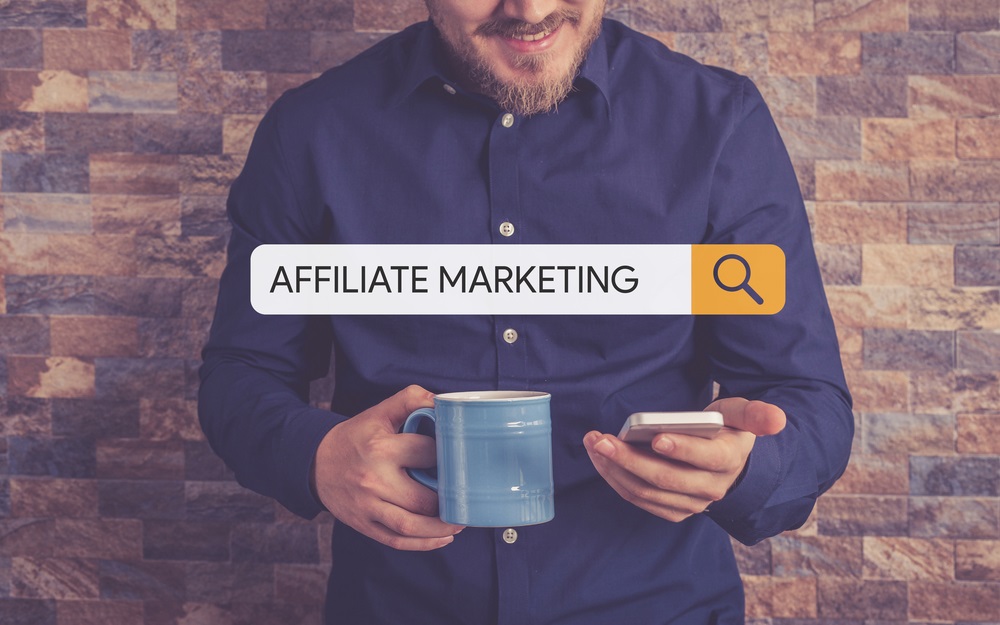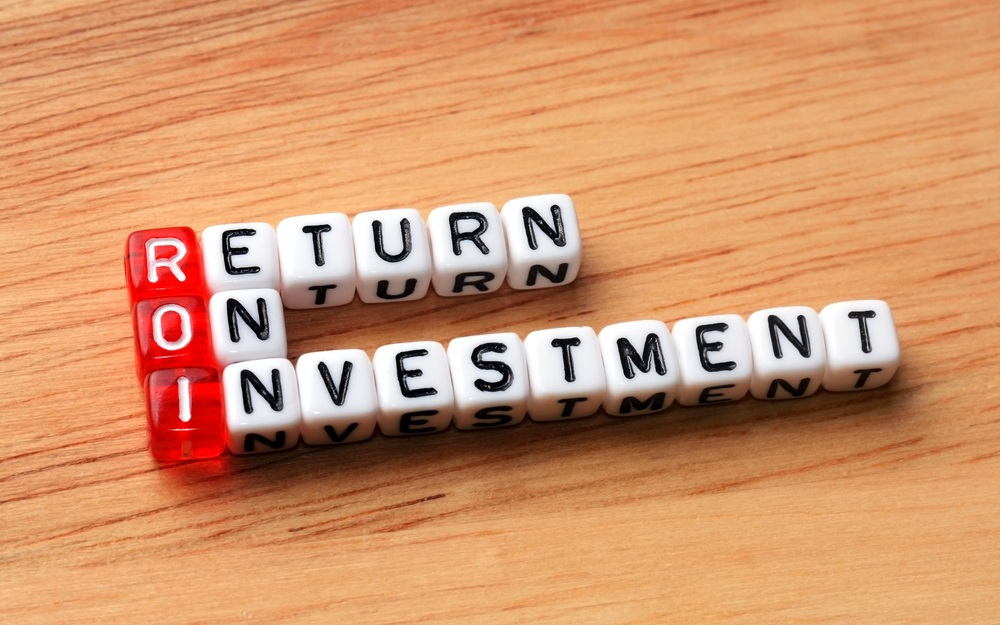Maximizing the performance of your marketing funnel is essential in order to attract and convert prospects into loyal customers. To do this, you must first understand all different steps involved in a successful funnel strategy—from uniting sales and marketing teams to utilizing digital media channels for personalization and post-purchase loyalty programs.
In this helpful guide, we’ll take an indepth look at how businesses can tailor their approaches with the goal of creating high conversion rates within their market funnels. Our plan will include strategies from collaborating between departments down to developing personalized messages using various online platforms such as social networks or webpages allowing businesses access powerful customer relationship tools including reward systems that promote loyalty amongst buyers over time.
Key Takeaways
- Understand the different stages of a marketing funnel and use content to engage prospects.
- Leverage digital channels, align sales & marketing teams, create effective landing pages and utilize email for conversions.
- Analyze customer journeys with Google Analytics, build loyalty programs post purchase and nurture leads through personalization.
Decoding the Marketing Funnel: A Comprehensive Overview
It is important to understand how the marketing funnel works in order to craft an effective and successful strategy. It serves as a powerful framework that helps businesses chart out prospects’ journey from being aware of their existence through making a purchase decision, consisting of numerous stages each requiring unique approaches towards achieving objectives. Through gaining insights into its complexity, companies can adapt their initiatives according to particular needs at every stage while also nurturing relationships with customers for sustainable success.
To explain about this concept more closely. We will discuss on different stages within the context and go over what kind of content should be used throughout the consumer’s journey from discovery till conversion by targeting audience correctly using sales funnels or other methods.
Understanding the Different Stages of a Marketing Funnel
The marketing funnel can be split into four essential stages: awareness, interest, desire and action. Every stage depicts a different step in the customer’s purchase journey. At the beginning, prospects become familiar with your company’s name and products or services through advertising campaigns and content, which sets off their buyer’s process. The middle section of the funnel focuses on producing enthusiasm for what you have to offer as well as encouraging potential buyers to learn more about it by engaging them further. They reach consideration where customers compare offers from rival businesses before eventually deciding whether or not to buy something from yours — this marks conversion into consumers after accomplishing an intended action such as subscription sign-up/buying goods etc. Grasping these separate parts along with each particular aspect should aid in effectively guiding people through all tunnel steps.
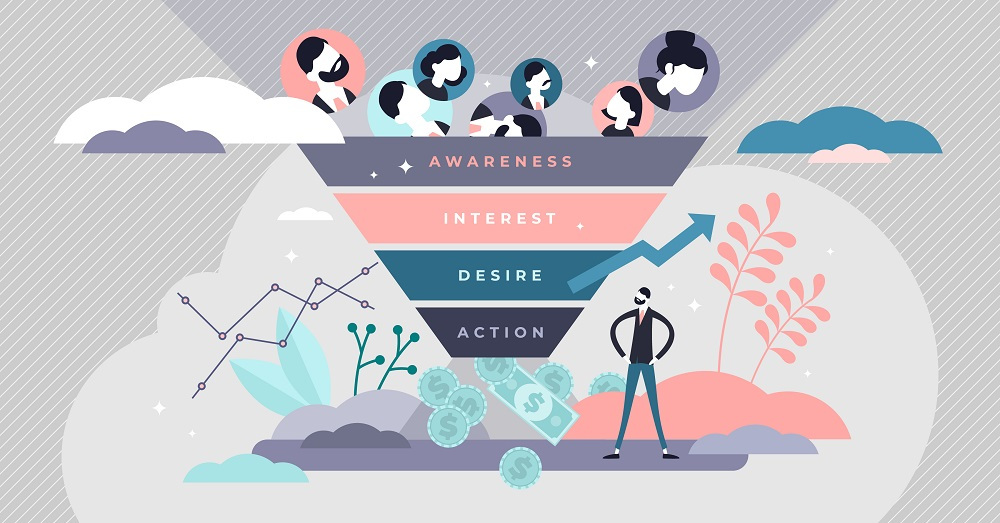
The Role of Content at Every Stage
Content is essential in guiding customers through each level of the marketing funnel. To draw people’s attention during awareness stage, relevant and enlightening content should be presented. Targeted information helps to stoke interest at the second step while persuasive material with effective CTAs can drive desired behavior by inciting desire for your products or services. By personalizing messages during the action stage that may include special offers, it is possible to facilitate smooth transition from one point to another thus increasing conversion rates throughout every phase of the funnel process.
Crafting a Marketing Strategy Around the Funnel
Funnel marketing is essential for designing a successful marketing strategy. Through the synchronization of teams and utilization of digital channels, you can create an engaging customer journey that meets your target audience’s needs at each step in the funnel with various tailored tactics. To do this effectively, it is necessary to understand what issues or difficulties potential buyers face so that informative content and solutions-oriented campaigns are developed.
By integrating sales and marketing tactics into one clear system within the funnel framework will help ensure prospects move through while increasing conversion rates significantly. All done by using multiple customised methods directed at those key individuals being targeted. Combining traditional communication techniques alongside new technology means maximum reach both inside online platforms as well as outside them, such as television ads etc.
Finally, leveraging existing data base relationships helps grow brand loyalty even Allowing businesses more opportunity to develop comprehensive multi channel initiatives across their entire organisation involving customers from initial contact right up until purchase close out stages.
Aligning Sales and Marketing Teams
Having marketing and sales teams that can work together effortlessly is essential for an optimal customer experience, as well as improved conversion rates. To align these departments, make sure each team has clearly defined roles and responsibilities, have them both share objectives, coordinate strategies in tandem to be more efficient with their efforts. Create a unified impression of the company by developing cross-functional squads. Maintain open dialogue between the two so they are able to construct a streamlined journey which drives quality leads towards greater profits through engaging customers throughout every step.
Utilizing Digital Marketing Channels
Digital marketing channels such as email, social media and content are important for connecting with prospects at every step of their journey. Social networks provide an ideal platform to build awareness and create relationships with potential buyers while emails can be used to foster leads and increase sales conversions. Content is also a powerful means of drawing people in, teaching them about your business or services while inspiring trust within the customer experience. By appropriately using these digital platforms while adapting material tailored to each target audience, customers will move along on this path to conversion more effectively. It allows you gain insights into what kind of messages resonate best when nurturing leads via email campaigns or other types of marketing strategies throughout different stages of the funnel.
The Conversion Funnel: Turning Prospects into Customers
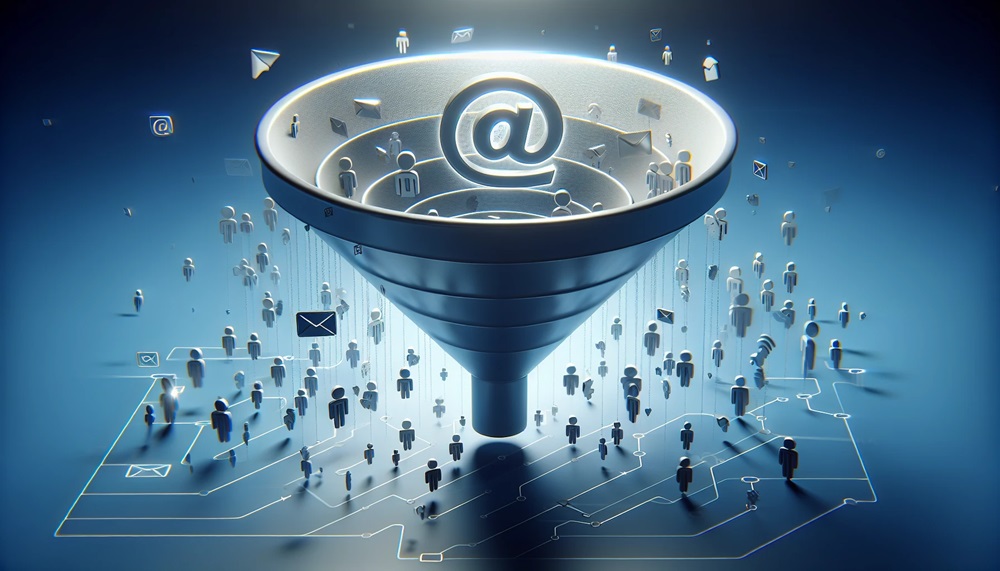
The process of converting prospects into customers can be achieved through the use of a conversion funnel, which guides them along the marketing funnel stages. Utilizing effective landing pages and email campaigns are key components for generating leads that will ultimately take action like purchasing an item or enrolling in a service.
This section looks closely at strategies such as designing successful webpages to acquire contacts, using emails to nurture those relationships and creating motivation among potential buyers. As well as how these techniques combine with other elements within the conversion funnel in order to transform prospective clients into actual ones.
Designing Effective Landing Pages
Landing pages serve as an essential element of a successful digital marketing funnel by acting as the first point of contact with potential customers. They should be designed to effectively capture leads and promote conversions, utilizing persuasive copy and prominent call-to-actions (CTAs). To achieve this goal, landing page design needs to engage your target audience visually, feature user friendly navigation for both desktop and mobile devices while still providing a clear CTA encouraging visitors to take that desired action, such as signing up for email lists or making purchases. Optimizing these elements in your landing page can increase chances of success when it comes to guiding prospects through the sales funnel into becoming actual paying customers.

Leveraging Email Marketing for Conversion
Email marketing is an extremely effective way to encourage customers along the conversion process. By constructing personalized emails and campaigns that are tailored for your target audience, you can produce more conversions. To gain maximum effectiveness from email promotion:
- Divide up contacts into different segments so relevant information goes to those who would benefit most from it.
- Automate delivery of messages based on customer history or preferences in order to ensure proper timing and accuracy with content sent out..
- Provide offers and messaging which strikes a chord with people within each segment – this will help move them down through the funnel until they become loyal clients as a result!
Measuring Success: Marketing Funnel Metrics
In order to ensure peak performance in our marketing funnel, it’s important that we accurately assess its success. Utilizing Google Analytics and industry standards for comparison are two key tools necessary for evaluating customer journeys. This way you can identify where improvements need to be made and take steps towards attaining the desired goals of your strategy. With a better comprehension of these metrics by making data-driven decisions, optimizing the effectiveness of the marketing funnel is much more achievable as well as an increase in conversion rates being likely results.
Analyzing Customer Journeys with Google Analytics
Google Analytics is a powerful tool to help analyze customer journeys and spot areas for improvement in the marketing funnel. It allows you to gain insights into user behavior, such as pages visited, time spent on each page, and exit points. This can be leveraged to maximize your customer journey performance.
To use Google Analytics for analyzing these paths: first install its tracking code onto your website. Then create an GA4 property followed by setting goals/events – all of which are key steps that will collect data about users’ activity allowing efficient optimization of the funnel towards increased conversions through targeting problem spots identified with their dropped off visits.
By looking at where customers stop viewing/interacting or why there are more drop-offs during certain stages, gives insight on what requires optimizing so informed decisions could be made regarding enhancing one’s selling process overall.
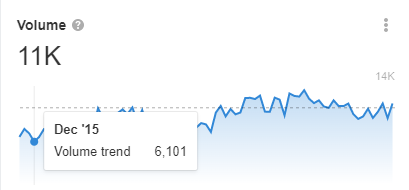
Benchmarking Against Industry Standards
Regularly assessing your marketing funnels against industry standards is necessary to ensure that all of the efforts being put forth are leading towards desired outcomes. You can compare performance metrics with those accepted in your sector and pinpoint areas which may require adjustments or optimization – such as targeting, content creation or advertising campaigns.
By following this evaluation process you will be able to stay on top of how well suited they are for achieving objectives while keeping an eye out for potential opportunities. Continuous monitoring and testing versus benchmarks lets companies ascertain if their strategy is going in the right direction so changes can be made when needed.
Building Loyalty and Advocacy Post-Purchase

Once a sale is made, the successful marketing funnel isn’t over. Maintaining loyalty and promoting advocacy post-purchase plays an essential role in garnering repeat customers and creating strong customer relationships. By crafting effective loyalty programs as well as advocating your brand via customer testimonials and success stories, you can improve your reputation while encouraging additional sales down the road.
Let’s take a look at how to design suitable loyalty plans that inspire enthusiasm from clients, plus exactly what it takes to get positive reviews/achievements tales for your products or services!
Creating Loyalty Programs That Work
Loyalty programs that are suited to a specific target audience can be effective in motivating customers for repeat purchases and forming lasting relationships. To ensure success, the program should provide straightforward processes when joining up or cashing out rewards: easy ways of earning points. Straightforward methods to redeem incentives – all tailored according to your customer’s needs. Through designing loyalty initiatives which meet the requirements of those you serve, it will foster brand commitment and generate recurrent orders.
Encouraging Customer Testimonials and Success Stories
The power of customer testimonials and success stories in terms of demonstrating the credibility and dependability of a brand cannot be understated. Showcasing real examples from existing customers who have benefited from your product or service can serve as encouragement for potential buyers to make the decision they need.
To foster such feedback, here is what you should do: request reviews from those satisfied with their experience, offer rewards in exchange for these accounts, and set up an uncomplicated system through which people can submit their tales easily. Lastly, show off this material on social media platforms too so that prospects will understand just how reliable it is buying products/services provided by you.
Nurturing Leads Through Personalization
To create an effective lead nurturing and personalization process, it is important to understand the target audience’s needs as well as preferences. Through this analysis of buyer personas, customized content can be delivered to prospects in order to drive them through the marketing funnel effectively.
By utilizing automation within these campaigns, you are able to provide leads with personalized experiences that will nurture their progress towards a conversion goal. In other words, by understanding your potential customers better, you can turn insights into powerful tailored offers and guide buyers down the right path!
Developing Buyer Personas
To create successful marketing initiatives, it is essential to understand your target customers and develop buyer personas. This involves researching customer preferences, behaviors and needs through surveys or interviews in order to identify the key attributes of an ideal user profile. With this information, you can build fictional representations that will enable marketers to design campaigns tailored for their intended audiences. Resulting in personalized messages resonating with prospects which guide them down the sales funnel more efficiently.
Using Marketing Automation to Nurture Leads
For powerful lead nurturing and marketing funnel navigation, utilize the strength of automated marketing. By automating processes such as emailing campaigns, scoring leads and setting up nurture programs, you can effectively interact with prospects while directing them towards successful conversion.
To make effective use of this technology: Divide your mailing list into distinct segments to ensure pertinent information is being sent to appropriate individuals. Leverage automation capabilities for timely emails personalized according to customer’s behavior or preferences. Supply targeted content that speaks directly to each potential consumer rather than bulk messaging strategies & encourage clients through the sales cycle until they become loyal customers.
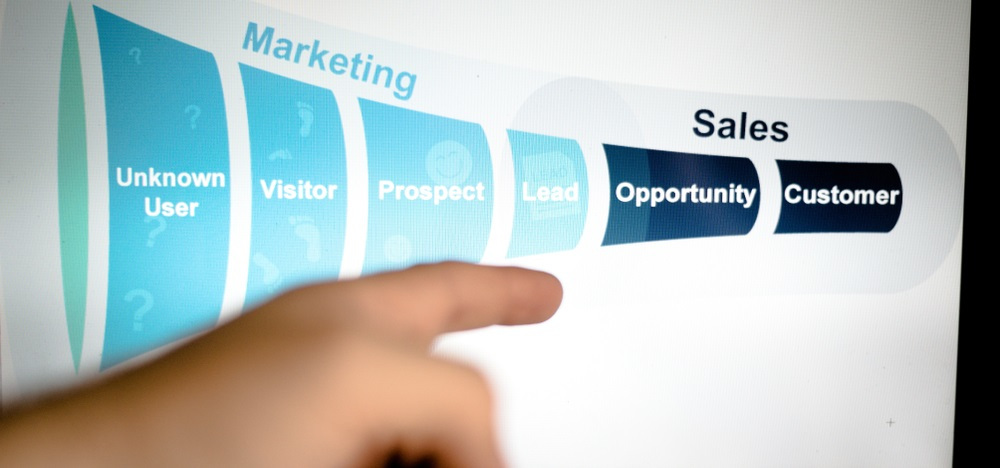
Summary
To sum up, for higher conversions and long-lasting customer relationships, it is important to ensure the efficiency of your marketing funnel. Through understanding all steps in the process, teaming sales & marketing teams together, as well as using digital tools and channels appropriately, you can create a custom journey that takes into account specifics related to your target audience. Personalization options plus loyalty programs along with feedback from customers are central elements when aiming at nurturing leads while also promoting recurring business activity. By consistently assessing performance levels achieved by this system, you will be able to gain maximum optimization through guaranteed ideal results! It’s now time to take action: start optimizing your own funnel today so it reaches its peak performance level!

